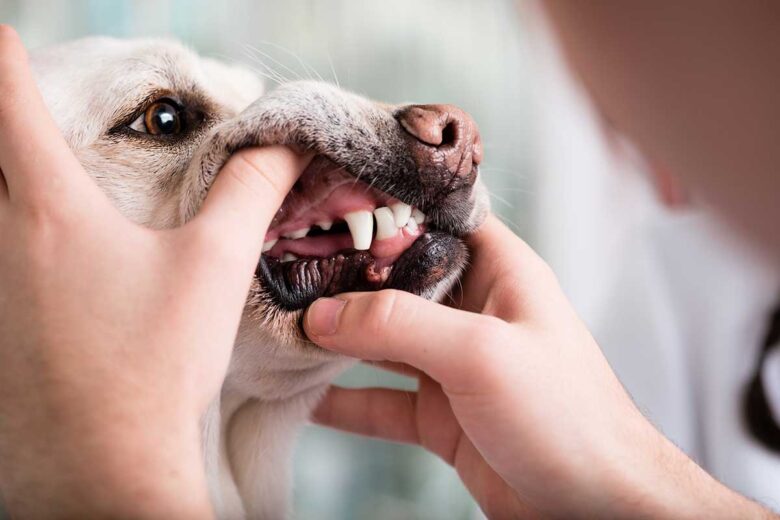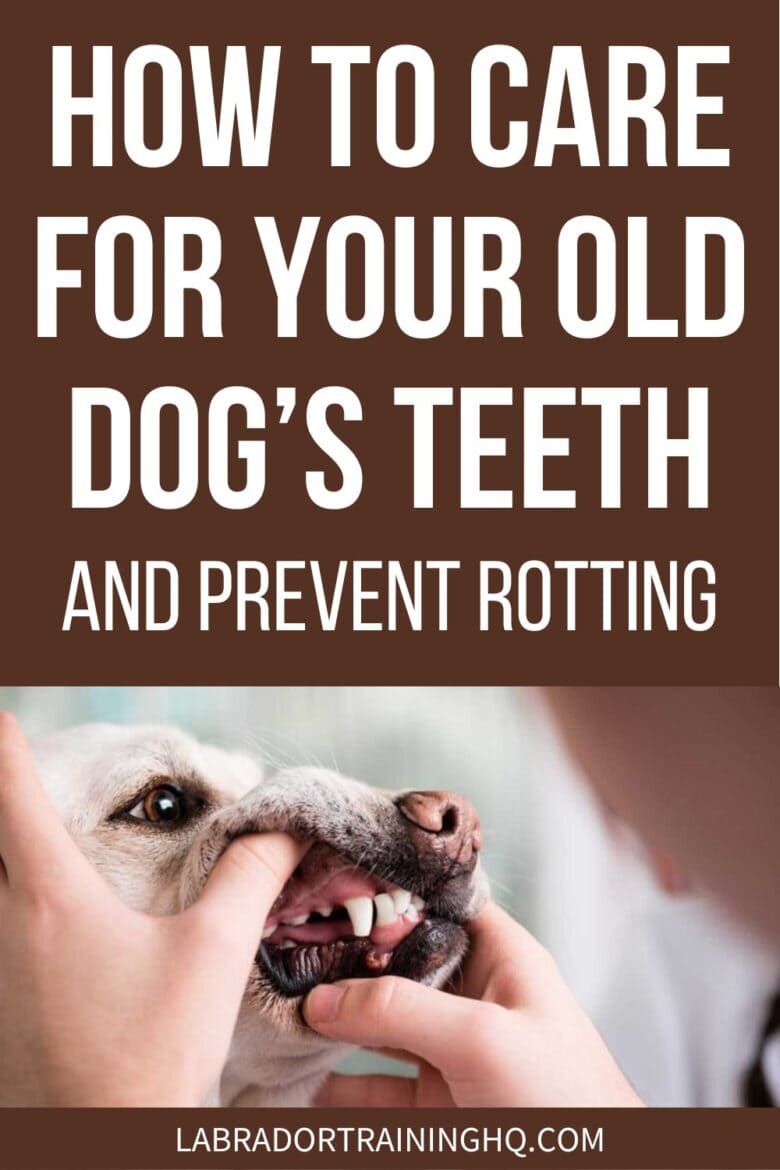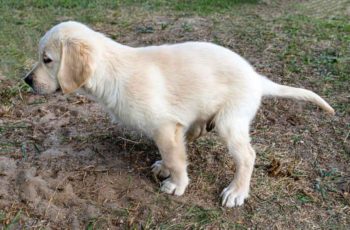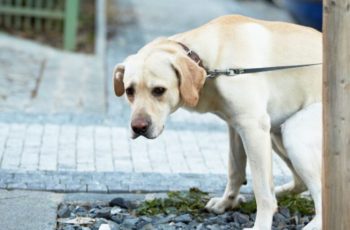This post may contain affiliate links. We may earn money or products from the companies mentioned in this post.
Young and old dogs often suffer from bad teeth, and many owners struggle with what to do about their poor pup’s problems.
Fortunately, dental issues are treatable and (even better) completely avoidable with consistent care.
There are many signs and symptoms you can look out for that will tell you if your dog has bad teeth i.e. periodontal disease.
Periodontal disease is serious and needs veterinary treatment in order to halt or prevent further damage to your dog’s mouth.
Luckily, the best treatment is prevention in the form of daily brushing and ensuring your dog has every tool to help themselves, such as water additives and teeth cleaning chew toys.
Read on to find out how to detect bad teeth in your dog, what it ultimately means for your best furry friend, and how you can keep them free of dental issues right from puppyhood to old age.

Contents & Quick Navigation
A Quick Product List For You
Throughout this article, specific products will be recommended for different treatment and prevention options for your old dog’s teeth. Here they all are for your convenience:
Signs Your Old Dog May Have Rotten Teeth
There are signs you can watch out for that can tell you if something is wrong with your dog’s teeth.
You should generally check your senior dog’s mouth every day when you clean their teeth for visible signs of tooth decay.
When doing a physical check of your dog’s mouth, look out for:
- Bleeding gums
- Food particles stuck between the teeth
- Rotten or fishy-smelling breath
- Loose teeth
- Thick, yellowish tartar build up
- Broken teeth
- Very red gums
- Swollen gums
- Open wounds in the mouth
- Pus around the gum line
- Swelling of the cheeks or around the eye socket (severe tooth abscess)
There are other signs your dog may be having a hard time with their teeth even if you can’t see anything wrong in their mouth.
Watch your dog for the following behaviors:
- Excessive drooling when eating
- Chewing and then dropping their food
- Blood in their food bowl after eating
- Bloody saliva
- Eating the soft food and leaving the hard food
- Chewing on one side of the mouth
- Refusing to eat
- Whimpering when eating or playing with chew toys
Any of these signs and symptoms may indicate your dog is developing or has periodontal disease and needs a vet’s attention as soon as possible.
What Is Periodontal Disease?
Periodontal disease is incredibly serious and can become life-threatening if left untreated.
It occurs when there is inflammation and infection of the gums, the ligaments that attach the teeth to the gums, the bone within the gum line that protects the roots, and the teeth.
Periodontal Disease Progression
Inflammation happens when your dog’s saliva mixes with their food and builds up on the teeth around the gum line and forms plaque.
Over time, this build-up of plaque becomes the perfect home for bacteria to live and breed. This leads to more inflammation and infection of the tissue; your vet may call it gingivitis.
If the plaque is not brushed off daily, it begins to harden into tartar (also called calculus).
Tartar is very hard and cannot be removed by simple brushing at home; a general vet or dental vet will need to remove it from your dog’s teeth, most likely while your dog is under anesthesia.
If the tartar is allowed to build up for an extended period of time, it leads to increased inflammation and a loss of the bone inside the gum which anchors to the tooth root in the jaw.
This means the teeth will loosen and fall out if it goes untreated.
Stages Of Periodontal Disease
There are different stages of periodontal disease which your vet will determine from an exam and dental x-rays.
| Stage Of Periodontal Disease | Severity Of Periodontal Disease |
| Stage 0 | Some tartar is evident |
| Stage 1 | Tartar is evident, gingivitis is evident, no bone loss |
| Stage 2 | Tartar is evident, gingivitis is evident, 25% bone loss |
| Stage 3 | Tartar is evident, gingivitis is evident, 25% to 50% bone loss |
| Stage 4 | Tartar is evident, gingivitis is evident, more than 50% bone loss |
Overall Health Risks Of Periodontal Disease
Apart from the obvious risk of tooth decay and your dog ultimately losing all of its teeth, there are other health risks to consider which periodontal disease can lead to.
Whenever there is an infection in the body, there is a chance that infection will spread to the blood and cause mass organ failure.
A small tooth abscess may seem relatively simple and harmless, but it can ultimately mean death if it is left untreated.
With periodontal disease, your dog will eat less, and this will slowly lead to gradual weight loss. Your dog may become underweight without you noticing at first.
If your dog is experiencing daily pain from trying to eat, and they stop eating, they will experience a lack of energy. Constant chronic pain will also affect your dog’s mood and general health.
There is also a chance that the infection in the gums can travel to the heart valves, which will eventually fail and cause death.
How To Prevent A Senior Dog’s Teeth Going Bad
There are a couple of ways to keep your old dog’s teeth from going bad and becoming damaged. These methods are fairly simple and should form part of your dog’s daily routine.
Brushing
How often do you brush your teeth?
Hopefully, your answer is twice a day!
Why should your dog’s teeth not be given similar treatment?
Your dog should have their teeth brushed once a day to continuously remove the plaque and prevent tartar from building up.
Use a toothbrush and toothpaste specifically designed for dogs. Human toothpaste is toxic to dogs, and even the organic kind can hurt them or make them sick.
There are two main kinds of toothbrushes for dogs: a silicone one that goes on the end of your finger and a more conventional brush.
It will come down to preference for you and your dog which you end up using every day. Smaller dog breeds may struggle with the silicone finger brush, as their mouths are very small.
In addition to the products recommended in this article, here is a list of all the products the Veterinary Oral Health Council recommends along with whether they are available directly to consumers or if they need to be purchased from a registered vet.
Water Additives
Water additives can act as a breath freshener by gently fighting bacteria throughout the day and can help prevent tartar build up.
Water additives are simple to use, as you just put the correct amount in your dog’s water bowl every day and help them fight dental disease every time they go for a drink.
The bonus of water additives is your dog’s breath will have a cleaner smell to it!
Dental Chews
Dental chews are edible treats given to dogs which have cleaning properties in them.
Not only do they help keep your dog’s teeth clean, but they also deposit a protective coat on the teeth which prevents food from sticking to them.
When giving your dog dental chews, it is of vital importance you give them chews that are the correct size, as a too-small chew could be a choking hazard for a large dog.
Chew Toys
There are some chew toys that can help scrape the plaque off of your dog’s teeth as they chew on them.
These are not replacements for daily teeth brushing, as they cannot get to the back tooth or all around the teeth like a brush can.
However, they are fun and safe toys for your dog to chew on which help promote healthier dental hygiene.
Dental Food
Some dogs are more prone to developing periodontal disease because of the shape of their mouths and jaws.
Smaller dog breeds suffer from periodontal disease frequently because their mouths are very small and their teeth are packed tightly together.
If your dog is prone to periodontal disease, then feeding them a dental food specifically formulated to help with dental care is ideal and will help reduce their risk of developing dental issues.
How To Clean Your Dog’s Teeth
After your dog has eaten its dinner, they are nice and calm and definitely not in the mood for zoomies, then it is time for their daily brush.
It is important you remain calm and keep them calm. Use the recommended toothpaste and brush for this process.
Have water at hand as well as a towel, as this process can get messy. Apply some toothpaste to the brush, gently lift your dog’s lip, and start brushing your dog’s back teeth at an angle and move around the mouth.
It is important to be gentle on the gums to avoid scratching them and making them bleed. Rinse the brush frequently and wipe your dog’s mouth afterwards.
Always end the teeth brushing session with a treat to reinforce a positive experience.
For a more detailed look at how to clean your dog’s teeth, check out this article.
FAQs About Your Dog’s Teeth
Is bad breath normal for dogs?
While your dog is not going to have breath smelling of roses and potpourri, bad or fishy breath should not be coming from their mouths and is an indication something is wrong.
Check out this article for detailed reasons why your dog’s breath may be stinky.
Is a dog’s mouth cleaner than a human’s?
It is an old myth that a dog’s mouth is cleaner than a human’s mouth. All animals have bacteria in their mouths.
Dogs and humans have high bacteria loads in their mouths; however, the types of bacteria are different.
Never let a dog lick an open or healing wound, and always seek medical attention for a dog bite, especially if it breaks the skin.
Does dry food clean a dog’s teeth?
Dry food does scrape some plaque and tartar buildup off your dog’s teeth. However, it is a tiny amount compared to the amount that needs to be cleaned off every day.
However, this does not mean your dog can then live off soft food. Dogs need to crunch down on dry food to stimulate their gums and keep their teeth strong.
A mixture of wet and dry food would be best for nutrition and daily brushing would be best rather than relying on their food to do the work.
Does chewing on bones, hooves, and antlers clean a dog’s teeth?
Allowing your dog to chew on bones, hooves, and antlers can actually lead to dental issues and not solve them.
Chewing on these hard items does not scrape off any substantial amount of plaque or tartar build up.
In fact, chewing on these items often leads to scraped and bleeding gums, broken teeth, and palate injuries.
Additionally, these chew toys split and stay moist after chewing, which can lead to serious bacterial build-up, which just ends up in your dog’s mouth when they chew it next.
It is best to avoid these items and go with safer chew toys.
Is it true my dog will get dental disease no matter what I do?
It is an old myth that dogs will develop dental diseases no matter what their owners do because they lick themselves, eat poop, and put anything they can into their mouths.
If you care for your dog’s dental health proactively, there is no reason they should ever get dental diseases.
Barking Off: What To Do About Old Dogs With Bad Teeth…
It can be difficult to figure out what to do about your old dog’s bad teeth and how to prevent them from rotting.
The best way to take care of your dog’s dental health is to be proactive and brush their teeth every day from the time they are a puppy.
Keeping your dog’s teeth clean will help prevent the onset of periodontal disease which, if left untreated, can become life threatening.
When cleaning and checking your dog’s mouth, look for signs of tooth decay such as:
- Bloody gums
- Loose or broken teeth
- Food stuck to teeth and gums
- Bad or fishy-smelling breath
- Pus, redness, or swelling around the gums
Look out for the signs your dog may be struggling with their teeth and implement daily changes to ensure they are getting the best care.
How do you take care of your old (or young pup) dog’s teeth?
Tell us about your dog in the comment section below.
Save To Pinterest

Top Picks For Our Dogs
- BEST PUPPY TOY
We Like: Calmeroos Puppy Toy w/ Heartbeat and Heat Packs – Perfect for new puppies. Helps ease anxiety in their new home. - BEST DOG CHEW
We Like: Bones & Chews Bully Sticks – All of our puppies love to bite, nip, and chew. We love using Bully Sticks to help divert these unwanted behaviors. - BEST DOG TREATS
We Like: Crazy Dog Train Me Treats – One of our favorite treats for training our service dog puppies. - BEST FRESH DOG FOOD
We Like: The Farmer’s Dog – A couple months ago we started feeding Raven fresh dog food and she loves it! Get 50% off your first order of The Farmer’s Dog.
For a list of all the supplies we get for our new service dog puppies check out our New Puppy Checklist on the PuppyInTraining.com blog.
How To Care For Your Old Dog’s Teeth To Prevent Them From Rotting was last modified: January 15th, 2023 by


